Guitar World Verdict
Guitar World verdict: With a superb pickup pairing, radical yet classy design and a really great neck profile, the Sferata could be that rare beast, the bold new electric guitar design that’s also a crowd-pleaser.
Pros
- +
The offset body is fresh, bold and works.
- +
Great tones and playability.
- +
Includes a quality case.
Cons
- -
Nut is a little untidy.
You can trust Guitar World
What is it?
Rivolta’s Forma series comprises three all-original electric guitar shapes coming from the brilliant mind of Novo Guitars’ Dennis Fano, each a fever dream of Golden Era modernism that looks like a funhouse mirror reflection of a long-lost Ted McCarty collection, artifacts from an alternate timeline.
There is nothing really quite like it. The Quadrata, with its coffin-shaped silhouette? St. Vincent’s Ernie Ball Music Man signature guitar is probably the closest contemporary reference but even then, with all those angles, our eyes see it very differently. Is this what happens when you take a couple of belts of nitrocellulose lacquer with your porridge in the morning?
Then there was the Zenyata, which when viewed in the mustard-yellow stain of Miele Amber looked like the reappearance of the Gibson Moderne in an acid flashback – especially with that asymmetrical V-profile headstock. And yet that body shape, again, there’s nothing quite like it.
Of the three, the Sferata – the model that started the Forma series in the first place – is the most conventional, and our review instrument is resplendent in the aforementioned Miele Amber. It glows.
Opening the case is like that moment when Vincent Vega opens the briefcase in Pulp Fiction: “Yeah, we happy.” Rivolta also offers the Forma models in Toro Black and Ciliega Red (or what you’d call “Ebony” and “Vintage Cherry” in old money).
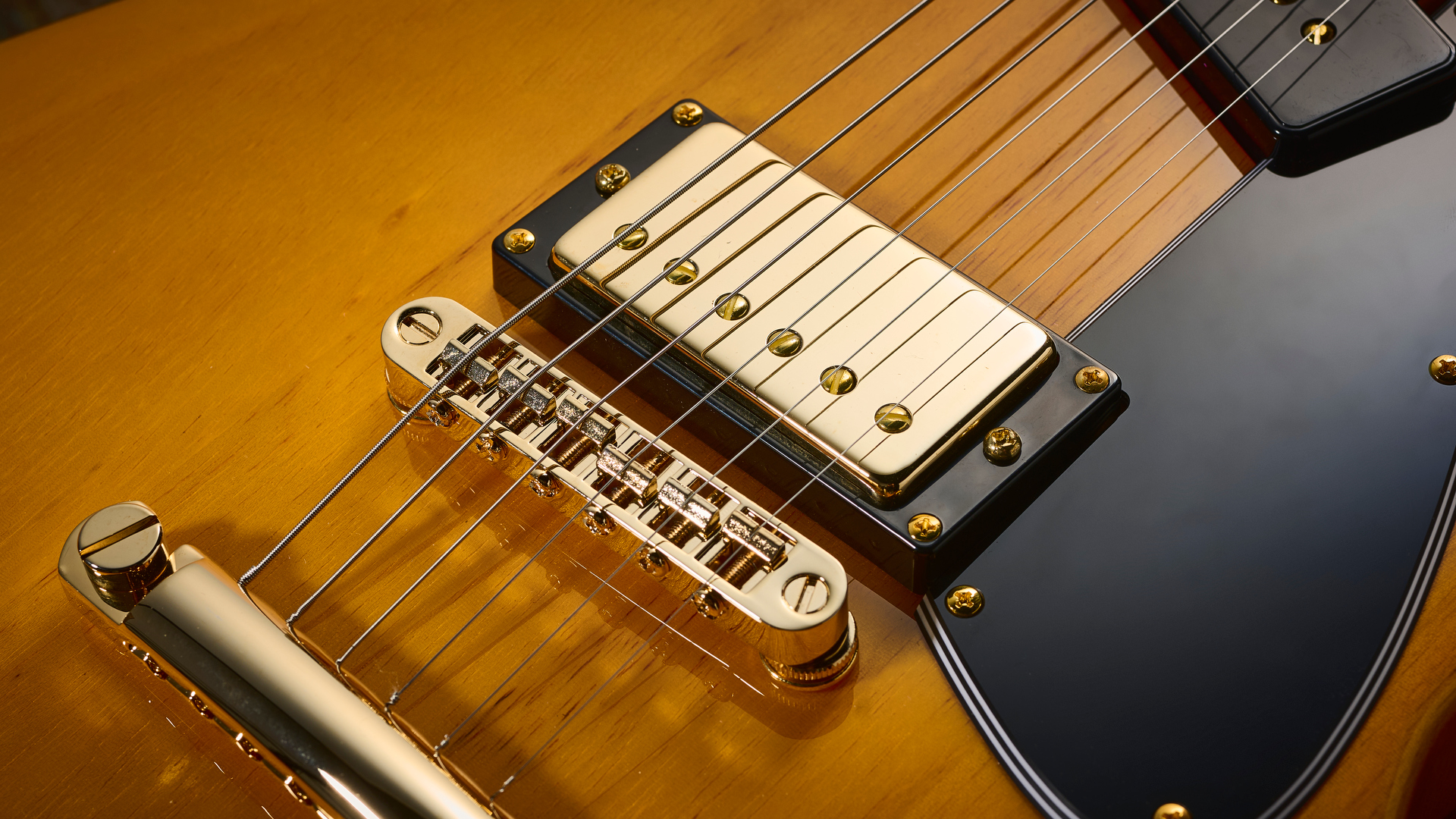
But the Forma series was not just about being original, introducing “primary shapes” to the guitar-buying public. These silhouettes might be avant-garde, retro-futuristic or whatever, but they are all designed with the player in mind. Ergonomics is a big part of the equation.
All three Forma series guitars have simarouba bodies, which admittedly is a new one on us but a tonewood that Rivolta describes as “ultra light weight, yet resonant”. The neck is also simarouba and is glued to the body. The fingerboard is dark Indian rosewood with pearloid/MOTO dot inlays has a 12” radius.
All the latest guitar news, interviews, lessons, reviews, deals and more, direct to your inbox!
It was inspired by the Fano Psonicsphear but there have been considerable revisions, not least to the body and build
Rivolta was formed in 2015 by Fano. The idea behind the brand was to make his designs more affordable. Rivolta’s guitars are built in South Korea by World Musical Instrument Co and then shipped back to the brand’s Nashville headquarters for QC and some setup TLC before heading out to dealers. At $1,699, you might consider them a more affordable pro-quality option. That price includes a super-sturdy and stylish Rivolta hardshell guitar case to sweeten the deal.
The Sferata is fashionably offset, technically a single cut albeit without what you’d call a lower horn – the cutaway angle runs nigh-on perpendicular to the body on the bass-side’s upper bout.
It was inspired by the Fano Psonicsphear but there have been considerable revisions, not least to the body and build. By comparison, the Psonicsphear had more of a Venetian cutaway and a flat top. The Psonicsphear’s six-in-line headstock has been swapped out for the 3x3 Forma series headstock.
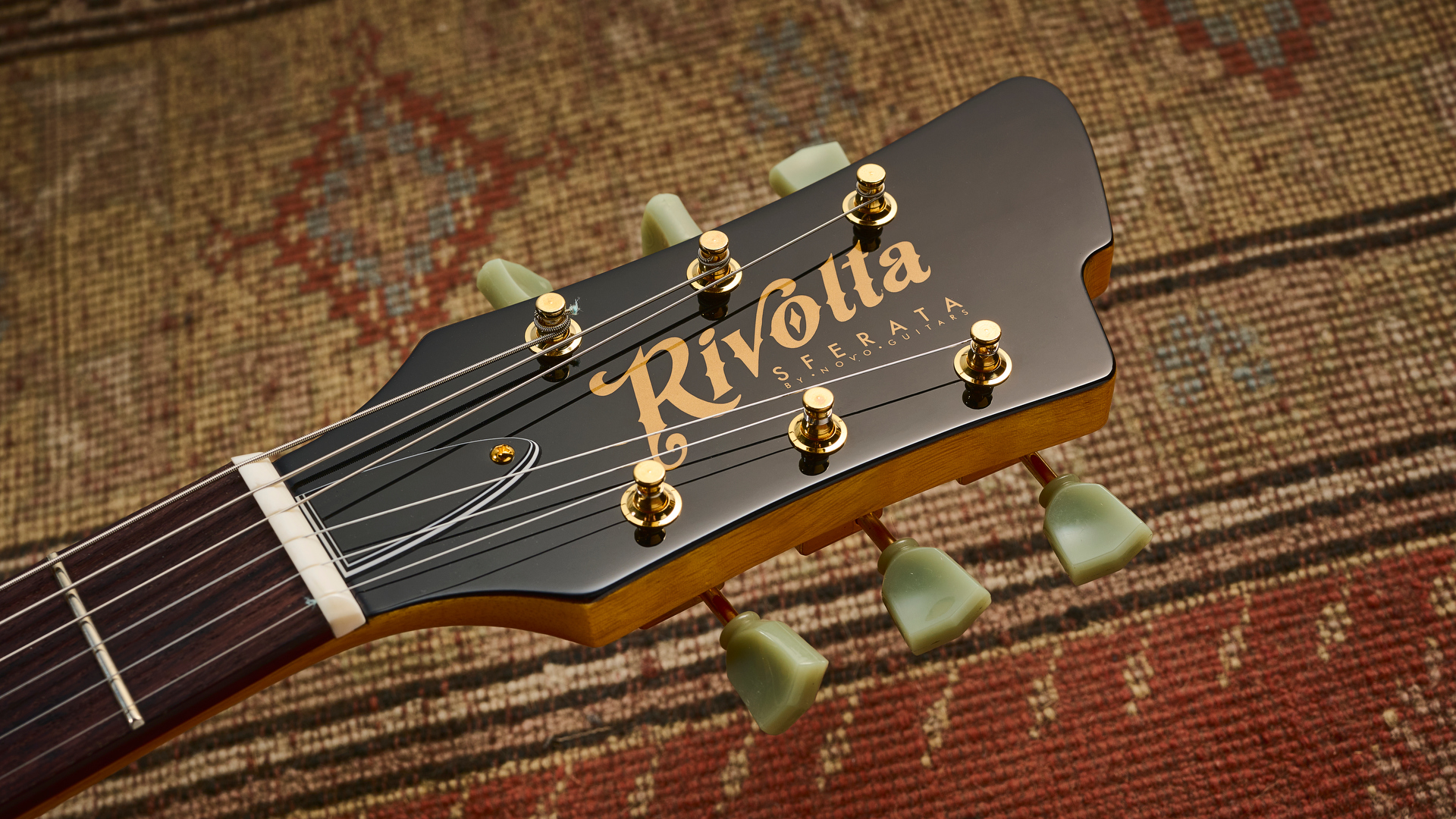
Oh, and if you think the Sferata is a little outré for the mainstream, remember the Psonicsphear had a chambered acrylic body with aluminum tone plates for that wild googie, Atomic Era vibe.
Like the others in the series, the Sferata has a soapbar-style P-90 pickup at the neck, mounted at an angle that eats up some of the fingerboard’s real estate – meaning that this is technically a 23 1/2 fret guitar – and there’s a humbucker at the bridge, a combination that is served by a three-way selector switch, volume and tone pots.
A TOM-style bridge and tailpiece and Wilkinson vintage tuners with snot-green buttons gives it a splash of vintage Gibson flavor, almost as a charitable gesture to reassure us with something we are familiar with while we get the head around the shape.
Specs
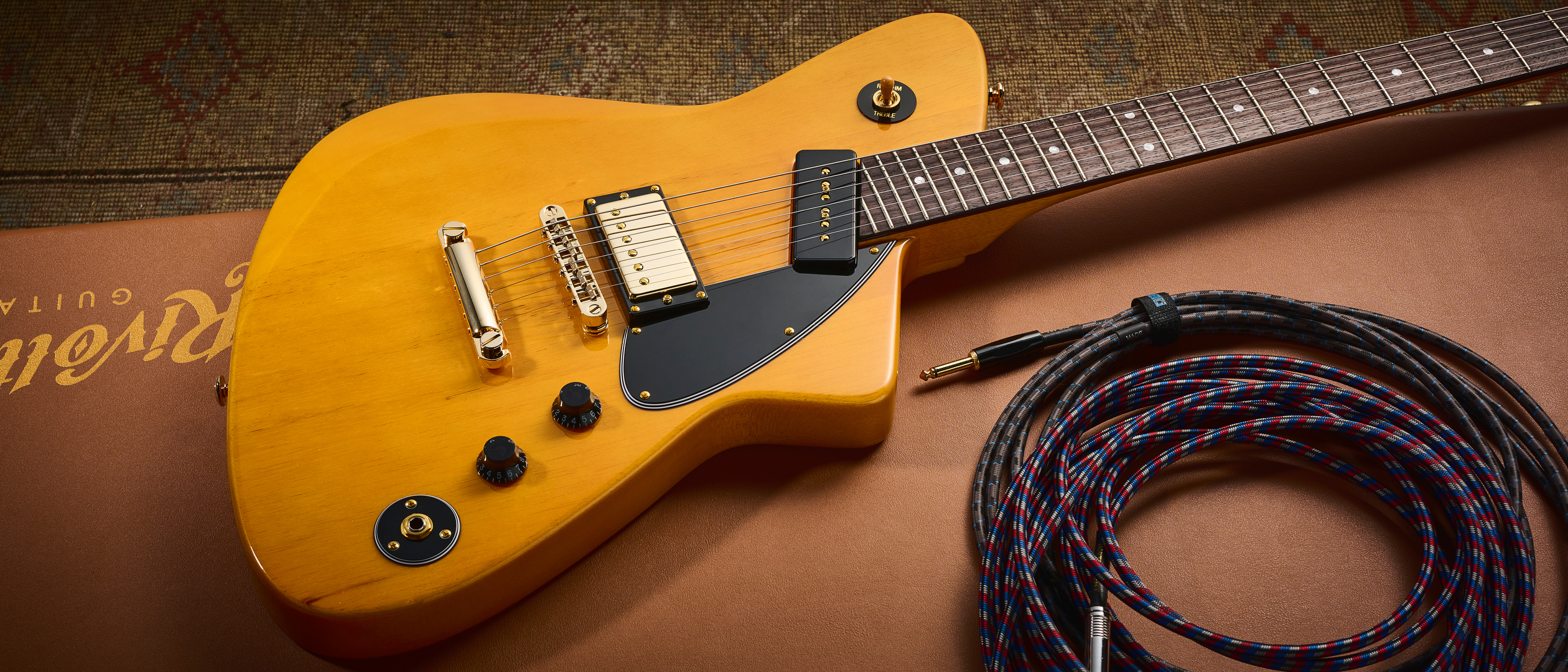
Launch price: $1,699 (£1,399 approx)
Made: South Korea
Type: Solid-body electric guitar
Body: Simarouba
Neck: Simarouba
Fingerboard: Rosewood, dot inlays
Scale length: 25"/ 635mm
Nut/width: Bone / 43mm
Frets: 23 1/2, medium jumbo
Hardware: Wilkinson tuners, TOM-style bridge and tailpiece (gold as reviewed, nickel on Ciliega Red model), multi-ply black pickguard
String spacing at bridge: 10 mm
Electrics: P-90 (neck), humbucker (bridge), 3-way pickup selector, volume, tone
Weight: 7.01 lbs / 3.18 kg
Options: None
Left-handed options: None.
Finishes: Toro Black, Ciliega Red, Miele Amber (as reviewed)
Cases: Yes, vintage-style fitted hardshell with pink plush lining
Contact: Rivolta Guitars
Build quality
Build quality rating: ★★★★1/2
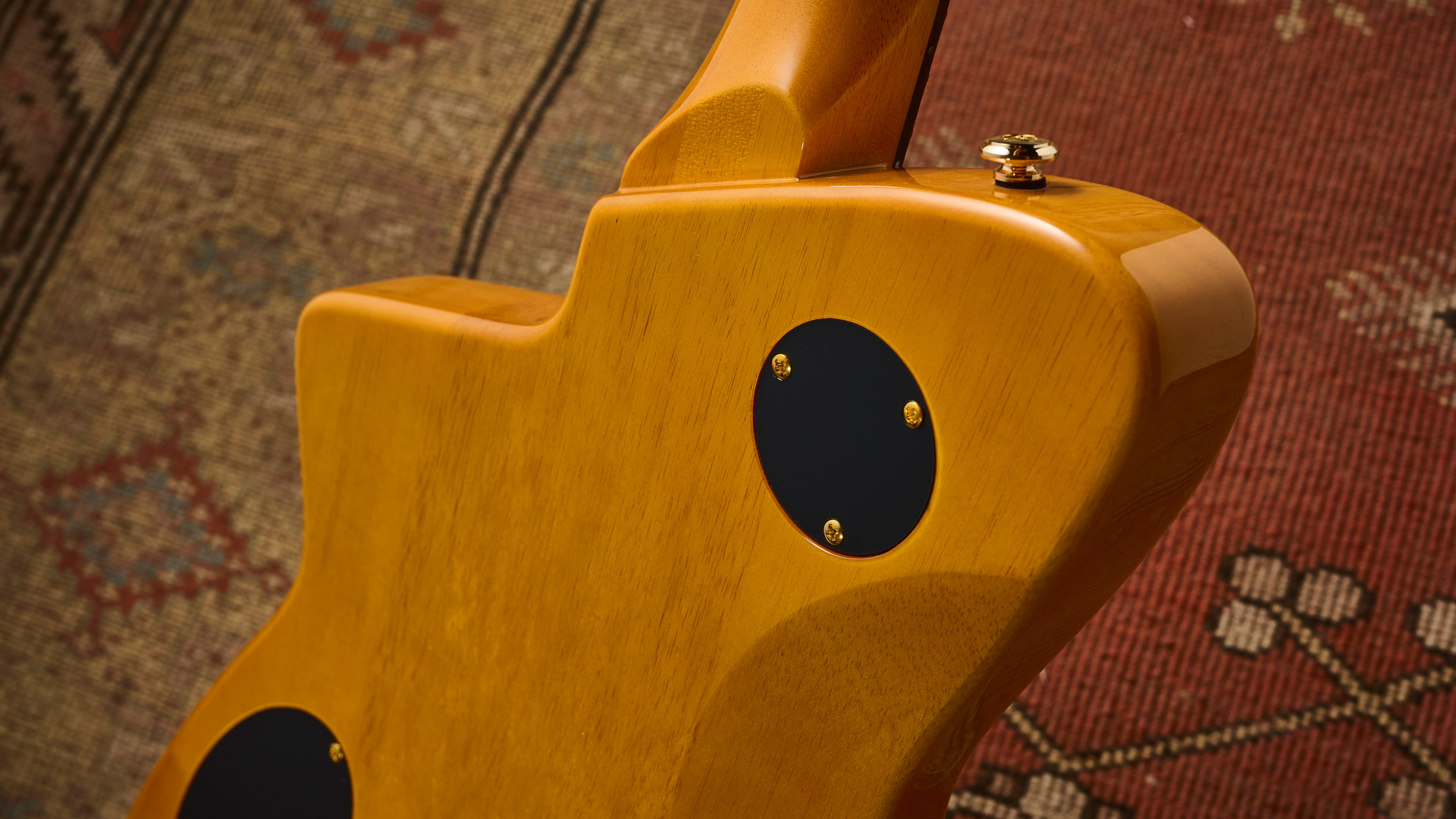
Guitar shapes can be graded for balance, how well they sit against the body when played seated or standing, practical considerations, but for most players it comes down to a question of aesthetics. You want the guitar to look good.
If Rivolta hadn’t published the specs we might have mistaken the Simarouba for korina
You can look at the pictures and judge for yourself, but for us, the Sferata shape works. As does the headstock, which is so often the deal-breaker on new guitar designs that do not have the weight of history behind them, or the cultural credibility that comes with an artist relationship.
If Rivolta hadn’t published the specs we might have mistaken the Simarouba for korina. The Miele Amber stain brings out a wood grain pattern that’s more subtle than ash. The body has a generous beveled forearm cut and there is a belly cut to enhance comfort – and trimming that timber also helps keep the weight down. All that chamfering on the top also catches the light nicely, adding yet another dynamic angle to a guitar that’s all angles.
That rosewood fingerboard looks the part, deep and dark brown, uniformly colored, and the 23 1/2 fret design is unlikely to trouble anyone; sure, you might get up to the 24th fret on the top two strings but don’t tell us you fret the double-octave E on that sixth string. That’s crazy talk.
The frets are medium jumbo, well installed, with no sharp edges on a fingerboard that has been left unbound. The tone and volume controls have a smooth, pleasing action – both sonically and mechanically.
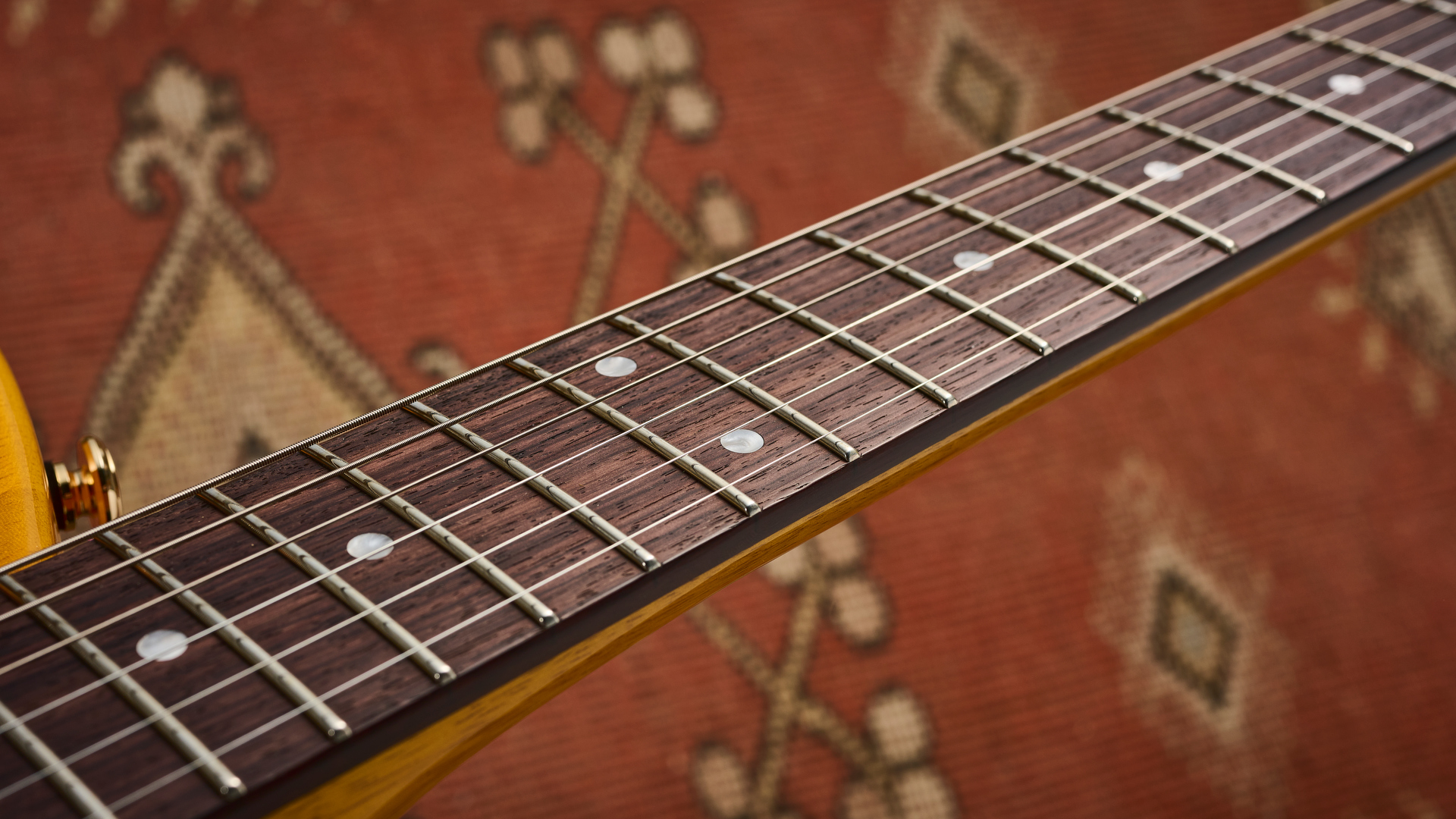
The Wilkinson tuners are smooth. All of this lends itself to that feeling that we have a jobbing professional’s guitar. The setup out of the case is bang-on for our tastes. The controls’ wiring and soldering is tidy.
We have a couple of minor niggles, firstly with the nut. Not that this bone nut is poorly cut. The strings sit nicely in it; there are no tuning issues. But it doesn’t sit quite flush with the side of neck. It’s a small thing but it’s untidy, and more noticeable because it’s hard to find much fault elsewhere.
Also, and this is a matter of opinion, but there is a dark knot on the body’s top just by the top-mounted instrument jack that might bother some. This sort of thing would be less of an issue on the alternative finishes. It is hardly a deal breaker.
Rivolta Forma Sferata: Playability
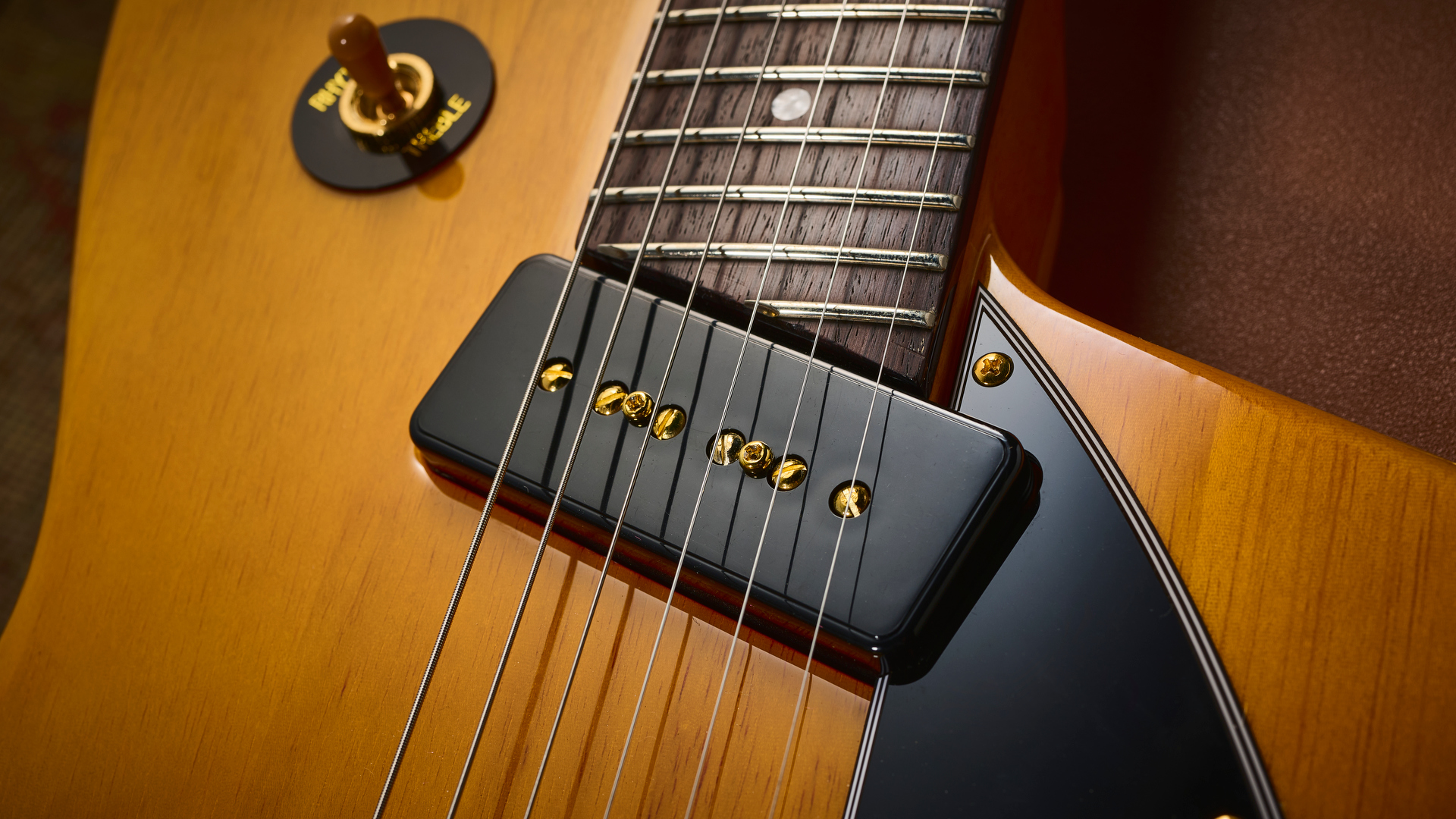
Playability rating: ★★★★★
The color and the shape of the Sferata is the big talking point but its success as an instrument lies in its superb neck profile
The color and the shape of the Sferata is the big talking point but its success as an instrument lies in its superb neck profile, and a feel that makes it so much fun, so compliant. And it’s not like this neck shape lacks substance.
This is not your “Modern C” profile; it’s more rounded, not quite crowding the palm but giving you just enough to hold onto for chords while getting out of your way for leads. It reminds us of a ‘60s Gibson SG Special we were once lucky enough to spend some time with, an old-school neck with timeless appeal.
With a 25” scale length, it’s not like we are far removed from the standard 24.75” on Gibson guitars or the 25.5” of Fender, but it will again offer a subtle point of difference in the Sferata’s fundamental dimensions and string tension.
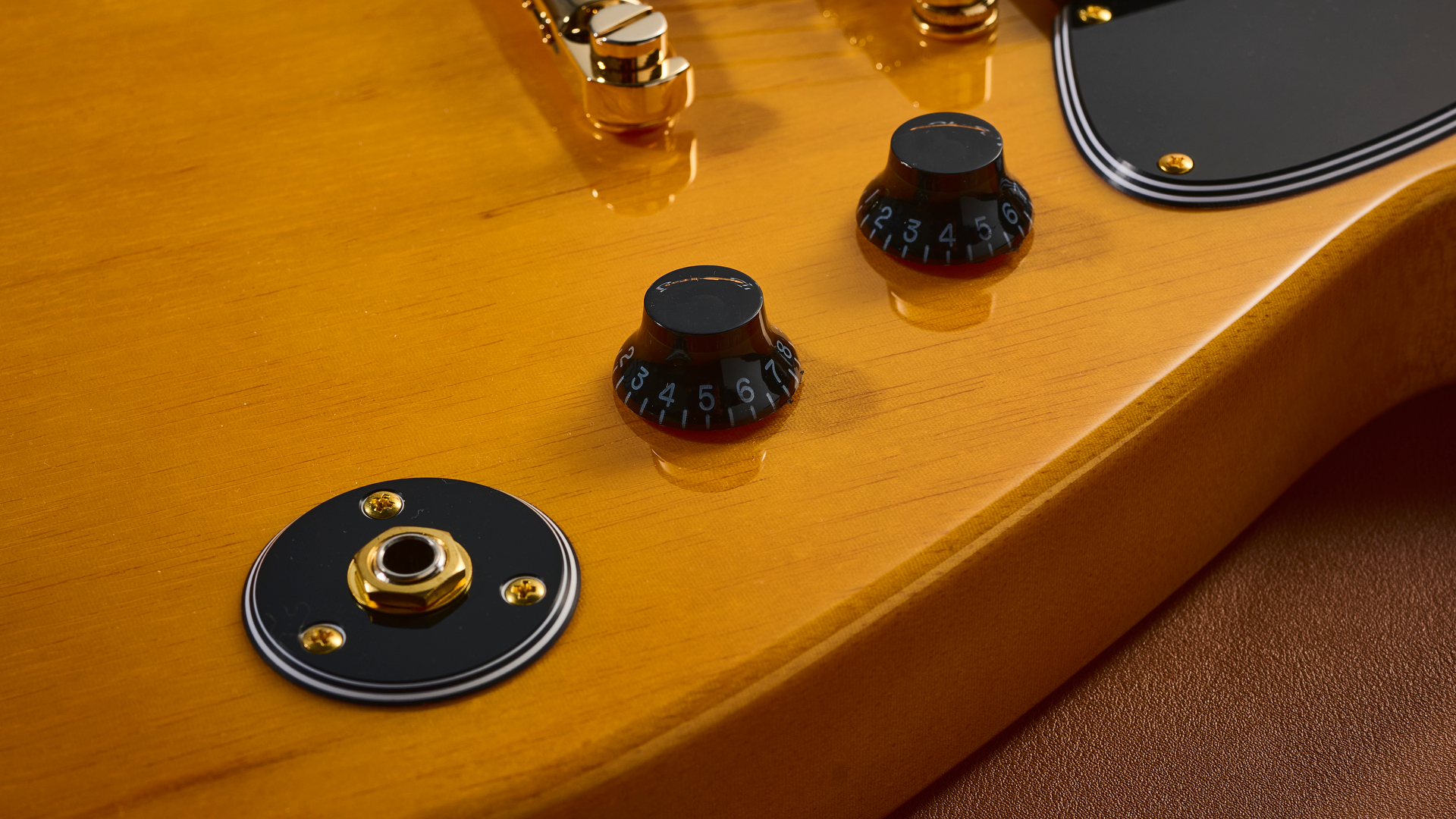
No guitar that I've played is quite like the Sferata. Everyone’s experience is different, but it feels a little more user-friendly than the Jazzmaster, the ür-offset against which all will inevitably be compared.
Again, it has an SG quality. Similarly, nothing on the fingerboard feels off-limits. That judicious – audacious – angle on the lower cutaway opens everything up.
But whereas the SG can feel like it’s all neck (not necessarily a caveat; the neck and fingerboard is where all the action is), this offset body, as light as it is at 7lbs, sits a little differently. The balance is spot on. It feels good on a strap. You could sit for hours with it. I have.
Sounds
Sounds rating: ★★★★1/2
There is a lot to be said for the versatility of the HSS Strat and similarly configured electrics but the hot midrange of the P-90 arguably makes a better bedfellow with a bridge humbucker
Rivolta doesn’t offer an abundance of information as to the provenance of the pickups here. There’s a P-90 soapbar at the neck, angled to match the lower cutaway, and a humbucker at the bridge: that’s all I need to know. And it might be all we could ever need either – as pickup configurations go, it could be the platonic ideal.
There is a lot to be said for the versatility of the HSS Strat and similarly configured electrics but the hot midrange of the P-90 arguably makes a better bedfellow with a bridge humbucker. It is a rock ’n’ roll pickup. It is a blues pickup. It is a punk-rock pickup.
It can even be a metal guitar pickup. Ask Tony Iommi. Or consult your pedalboard; the P-90 at the neck, paired with fuzz pedal, EQ it so there’s just enough treble to lift the high-end and this great for old-time ‘70s rock and proto-metal riffs, and yes it’s a little noisy but that’s part of the deal. Super-clean with the spritz of spring reverb, however, and you’re back in the 1950s.
I did say from the start that, with the Forma Series, Rivolta was playing around the electric guitar’s timeline but we were talking lines, contours, finish options and hardware. Turns out, it was playing a similar game with the tones.

Run the neck pickup bright and it’s super-articulate, especially for jazz chords, played clean or with just a little bit of hair on the amp
There is a lot of range on the Sferata’s tone pot. Roll it all the way back and with a clean tone you’ve got what sounds like someone threw a warm blanket over a piano. Run it bright and it’s super-articulate, especially for jazz chords, played clean or with just a little bit of hair on the amp.
The mix position offers a distinct flavor of its own. As with any other dual-pickup guitar, it’s often where the undecided find themselves, or those who have arrived at the bridge and need to switch things up. It sure does sound nice with some chorus on it.
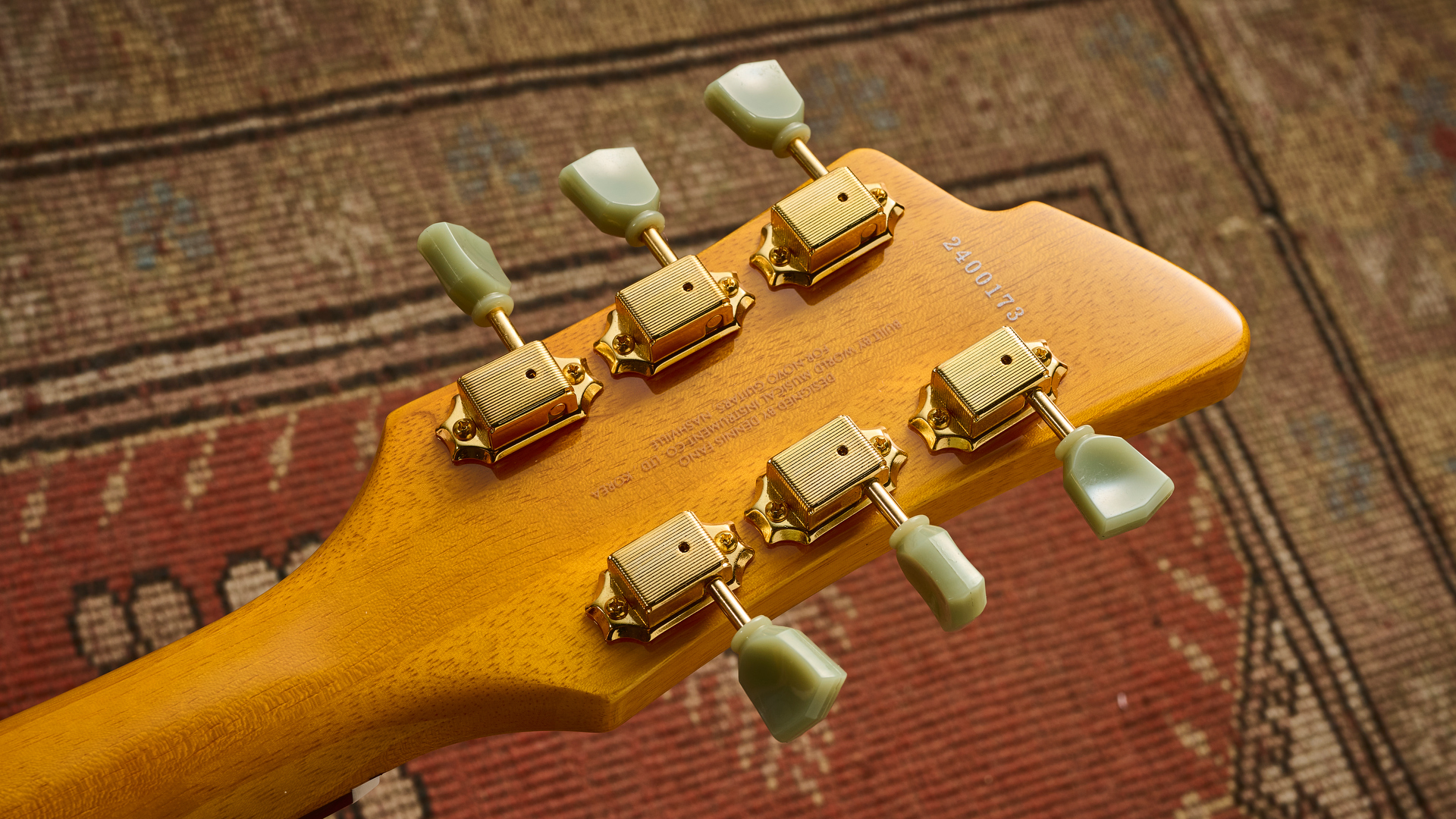
If the neck is all about full access then the Sferata’s core tones are a blank canvas. There’s very little this can’t do. The bridge humbucker is a hard-working pickup, with tones that skew vintage.
Crank the gain and you can get squealing harmonics and all the juice you need for hard-rock, ‘80s metal too, but it is a fine all-rounder, and a superb blues and rock pickup, showing its teeth when you lean into a string bend, nice and balanced for power chords. The radical yet incalculable element in this tone equation is the simarouba.
No question it is a lot lighter than our ash-bodied Telecaster. Looking at the online ‘league tables’ of tonewood density it might be positioned somewhere between alder and basswood but what does this tell us when our ears are hearing tones that feel adjacent to or at least not that far removed from Gibson’s greatest hits on one guitar? It doesn’t lack sustain.
Verdict
Thinking of scale, it would be fascinating how the Sferata’s design could be sized-up and applied to a baritone guitar. Perhaps that’s one for Fano to think about in future. A baritone with a Bigsby? Why not? If the Sferata finds an audience, and it should, this could be a new archetype.
There is something to be said for building an offset with a set neck. It’s a commitment. From the aesthetics to the feel and the sounds, the Sferata is wholly convincing, built of conviction.
The Sferata might be a 21st-century design but it’s got a whole lotta 20th-century mojo
It is a superb rock guitar, which might be its calling given that its bold outline might scare off trad blues players who still hold hope for finding a single-owner Burst at a garage sale. But they should ignore this at their peril and remember Albert King; he liked a shape.
The Sferata might be a 21st-century design but it’s got a whole lotta 20th-century mojo with that golden amber finish and those golden era vibes. I love it.
Guitar World verdict: With a superb pickup pairing, radical yet classy design and a really great neck profile, the Sferata could be that rare beast, the bold new electric guitar design that’s also a crowd-pleaser.
| Test | Results | Score |
|---|---|---|
| Build quality | Superb original design, considered spec. | ★★★★1/2 |
| Playability | Great neck, good weight, hard to put down. | ★★★★☆ |
| Sounds | P-90 and humbucker combo is perfect for this offset. | ★★★★★ |
| Overall | Vintage mojo from an all-original 21st-century design. Fano's rep grows bigger. | ★★★★1/2 |
Also try
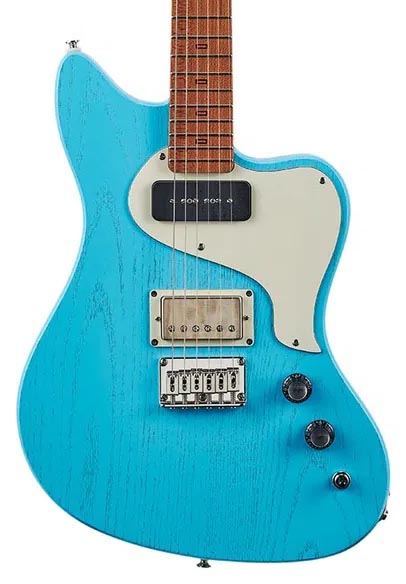
£1,899
PJD Standard
Fresh out of the UK, here's another lightweight offset with a P-90/humbucker pairing with "world-class sounds".
Read our review
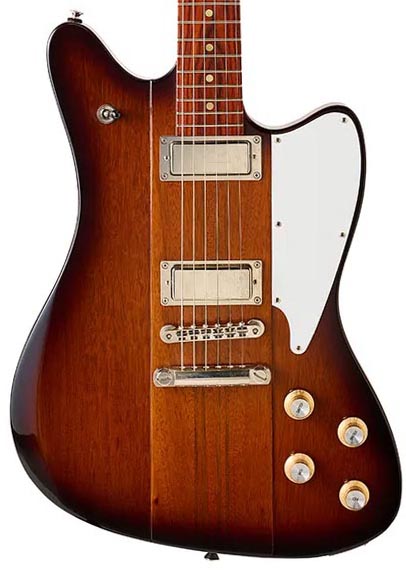
£3,999
Daniels Gravitas
Okay, we are shopping in a higher-price bracket but like the Sferata this feels like a vintage guitar that never was. Incredible.
Read our review
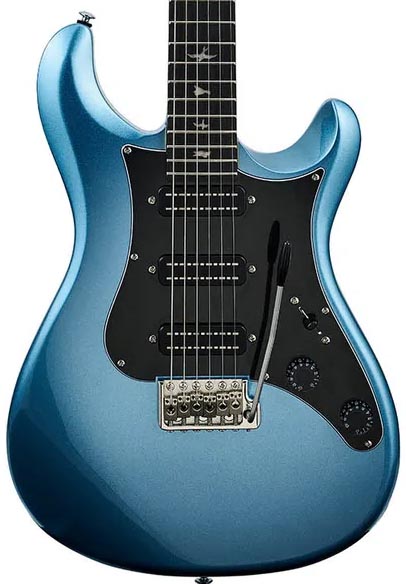
$799 / £979
PRS SE NF3
The SE line is a great example of how a US builder can collaborate with an Asian manufacturer to offer more affordable models with superb quality. This NF3 is "dangerously close" to US quality.
Read our review
Hands-on videos
Rivolta Guitars
R.J. Ronquillo
Jonathan Horsley has been writing about guitars since 2005, playing them since 1990, and regularly contributes to publications including Guitar World, MusicRadar and Total Guitar. He uses Jazz III nylon picks, 10s during the week, 9s at the weekend, and shamefully still struggles with rhythm figure one of Van Halen’s Panama.



